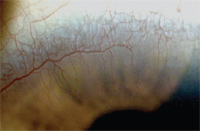Corneal neovascularization is the growth of new blood vessels into the cornea, which is normally avascular (lacking blood vessels). It can be a sight-threatening condition. This process can occur due to various factors, including:
- Hypoxia: Insufficient oxygen supply to the cornea, often seen in contact lens wearers.
- Infection: Certain infections can trigger an inflammatory response that promotes vascular growth.
- Inflammation: Conditions like keratitis or conjunctivitis can lead to neovascularization.
- Trauma: Injury to the cornea may stimulate new vessel growth as part of the healing process.
Photo from: https://www.reviewofcontactlenses.com/article/when-the-problem-is-not-infectious
Symptoms
- Visual disturbances or blurriness
- Redness around the cornea
- Discomfort or irritation
- Increased sensitivity to light
- Intolerance of contact lenses wear
Diagnosis
Diagnosis is typically made through a comprehensive eye exam (Slit-Lamp Examination)
- Addressing the underlying cause: For example, improving oxygenation for contact lens wearers.
- Medications: Corticosteroids or anti-VEGF agents may be used to reduce inflammation or inhibit vessel growth.
- Surgery: In severe cases, surgical options such as limbal stem cell transplantation may be considered.
Prevention
- Maintaining proper contact lens hygiene: switch to daily disaposable/Silicon Hydrogel material lenses and NO sleeping/naping with lenses on.
- Avoiding eye irritants, and
- Regular eye exams can help prevent corneal neovascularization.
If you have more specific questions or need information on a particular aspect, feel free to ask!

